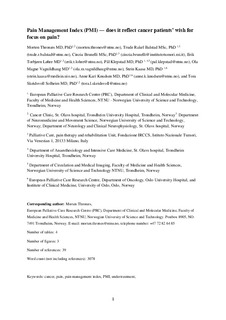Pain management index (PMI)-does it reflect cancer patients? wish for focus on pain?
Thronæs, Morten; Balstad, Trude Rakel; Brunelli, Cinzia; Løhre, Erik Torbjørn; Klepstad, Pål; Vagnildhaug, Ola Magne; Kaasa, Stein; Knudsen, Anne Kari; Solheim, Tora Skeidsvoll
Journal article, Peer reviewed
Accepted version

Åpne
Permanent lenke
http://hdl.handle.net/11250/2631663Utgivelsesdato
2019Metadata
Vis full innførselSamlinger
Sammendrag
Background
The pain management index (PMI) was developed to combine information about the prescribed analgesics and the self-reported pain intensity in order to assess physicians’ response to patients’ pain. However, PMI has been used to explore undertreatment of cancer pain. The present study explores prevalence of negative PMI and its associations to clinical variables, including the patient-perceived wish for more attention to pain.
Methods
A single-center, cross-sectional, observational study of cancer patients was conducted. Data on demographics and clinical variables, as well as patient-perceived wish for more attention to pain, were registered. PMI was calculated. Negative PMI indicates that the analgesics prescribed might not be appropriate to the pain intensity reported by the patient, and associations to negative PMI were explored by logistic regression models.
Results
One hundred eighty-seven patients were included, 53% had a negative PMI score. Negative PMI scores were more frequent among patients with breast cancer (OR 4.2, 95% CI 1.3, 13.5), in a follow-up setting (OR 12.1, 95% CI 1.4, 101.4), and were inversely associated to low performance status (OR 0.14, 95% CI 0.03, 0.65). Twenty-two percent of patients with negative PMI scores reported that they wanted more focus on pain management, versus 13% among patients with a non-negative PMI score; the difference was not statistically significant.
Conclusion
A high prevalence of negative PMI was observed, but only 1/5 of patients with a negative PMI wanted more attention to pain by their physician. Our findings challenge the use of PMI as a measure of undertreatment of cancer pain.